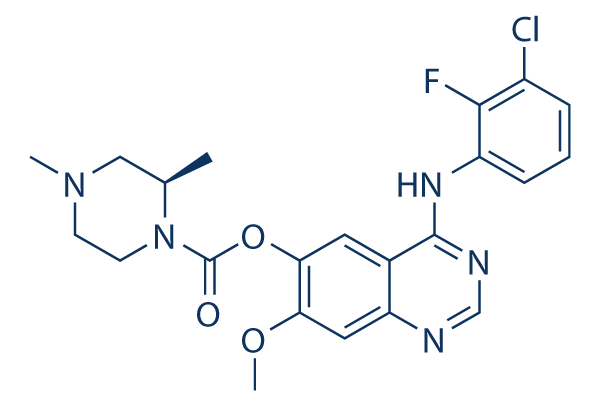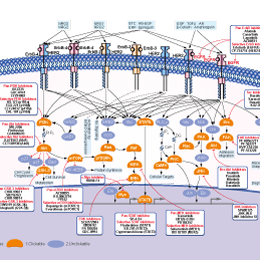
- 阻害剤
- 研究分野別
- PI3K/Akt/mTOR
- Epigenetics
- Methylation
- Immunology & Inflammation
- Protein Tyrosine Kinase
- Angiogenesis
- Apoptosis
- Autophagy
- ER stress & UPR
- JAK/STAT
- MAPK
- Cytoskeletal Signaling
- Cell Cycle
- TGF-beta/Smad
- 化合物ライブラリー
- Popular Compound Libraries
- Customize Library
- Clinical and FDA-approved Related
- Bioactive Compound Libraries
- Inhibitor Related
- Natural Product Related
- Metabolism Related
- Cell Death Related
- By Signaling Pathway
- By Disease
- Anti-infection and Antiviral Related
- Neuronal and Immunology Related
- Fragment and Covalent Related
- FDA-approved Drug Library
- FDA-approved & Passed Phase I Drug Library
- Preclinical/Clinical Compound Library
- Bioactive Compound Library-I
- Bioactive Compound Library-II
- Kinase Inhibitor Library
- Express-Pick Library
- Natural Product Library
- Human Endogenous Metabolite Compound Library
- Alkaloid Compound LibraryNew
- Angiogenesis Related compound Library
- Anti-Aging Compound Library
- Anti-alzheimer Disease Compound Library
- Antibiotics compound Library
- Anti-cancer Compound Library
- Anti-cancer Compound Library-Ⅱ
- Anti-cancer Metabolism Compound Library
- Anti-Cardiovascular Disease Compound Library
- Anti-diabetic Compound Library
- Anti-infection Compound Library
- Antioxidant Compound Library
- Anti-parasitic Compound Library
- Antiviral Compound Library
- Apoptosis Compound Library
- Autophagy Compound Library
- Calcium Channel Blocker LibraryNew
- Cambridge Cancer Compound Library
- Carbohydrate Metabolism Compound LibraryNew
- Cell Cycle compound library
- CNS-Penetrant Compound Library
- Covalent Inhibitor Library
- Cytokine Inhibitor LibraryNew
- Cytoskeletal Signaling Pathway Compound Library
- DNA Damage/DNA Repair compound Library
- Drug-like Compound Library
- Endoplasmic Reticulum Stress Compound Library
- Epigenetics Compound Library
- Exosome Secretion Related Compound LibraryNew
- FDA-approved Anticancer Drug LibraryNew
- Ferroptosis Compound Library
- Flavonoid Compound Library
- Fragment Library
- Glutamine Metabolism Compound Library
- Glycolysis Compound Library
- GPCR Compound Library
- Gut Microbial Metabolite Library
- HIF-1 Signaling Pathway Compound Library
- Highly Selective Inhibitor Library
- Histone modification compound library
- HTS Library for Drug Discovery
- Human Hormone Related Compound LibraryNew
- Human Transcription Factor Compound LibraryNew
- Immunology/Inflammation Compound Library
- Inhibitor Library
- Ion Channel Ligand Library
- JAK/STAT compound library
- Lipid Metabolism Compound LibraryNew
- Macrocyclic Compound Library
- MAPK Inhibitor Library
- Medicine Food Homology Compound Library
- Metabolism Compound Library
- Methylation Compound Library
- Mouse Metabolite Compound LibraryNew
- Natural Organic Compound Library
- Neuronal Signaling Compound Library
- NF-κB Signaling Compound Library
- Nucleoside Analogue Library
- Obesity Compound Library
- Oxidative Stress Compound LibraryNew
- Phenotypic Screening Library
- PI3K/Akt Inhibitor Library
- Protease Inhibitor Library
- Protein-protein Interaction Inhibitor Library
- Pyroptosis Compound Library
- Small Molecule Immuno-Oncology Compound Library
- Mitochondria-Targeted Compound LibraryNew
- Stem Cell Differentiation Compound LibraryNew
- Stem Cell Signaling Compound Library
- Natural Phenol Compound LibraryNew
- Natural Terpenoid Compound LibraryNew
- TGF-beta/Smad compound library
- Traditional Chinese Medicine Library
- Tyrosine Kinase Inhibitor Library
- Ubiquitination Compound Library
-
Cherry Picking
You can personalize your library with chemicals from within Selleck's inventory. Build the right library for your research endeavors by choosing from compounds in all of our available libraries.
Please contact us at info@selleck.co.jp to customize your library.
You could select:
- 抗体
- 新製品
- お問い合わせ
Zorifertinib (AZD3759)
Zorifertinib (AZD3759) is a potent, oral active, CNS-penetrant EGFR inhibitor with IC50 of 0.3 nM, 0.2 nM, and 0.2 nM for EGFR (WT), EGFR (L858R), and EGFR (exon 19Del), respectively. Phase 1.

CAS No. 1626387-80-1
文献中Selleckの製品使用例(6)
製品安全説明書
現在のバッチを見る:
純度:
99.87%
99.87
Zorifertinib (AZD3759)関連製品
シグナル伝達経路
EGFR阻害剤の選択性比較
Cell Data
| Cell Lines | Assay Type | Concentration | Incubation Time | 活性情報 | PMID |
|---|---|---|---|---|---|
| H3255 cells | Proliferation assay | 72 h | Antiproliferative against human H3255 cells expressing EGFR L858R mutant after 72 hrs by MTS assay, IC50=0.007 μM | ||
| PC9 cells | Function assay | Inhibition of EGFR exon19 deletion mutant phosphorylation in human PC9 cells, IC50=0.0074 μM | |||
| H838 cells | Function assay | Inhibition of EGFR phosphorylation in human H838 cells, IC50=0.0645 μM | |||
| 他の多くの細胞株試験データをご覧になる場合はこちらをクリックして下さい | |||||
生物活性
| 製品説明 | Zorifertinib (AZD3759) is a potent, oral active, CNS-penetrant EGFR inhibitor with IC50 of 0.3 nM, 0.2 nM, and 0.2 nM for EGFR (WT), EGFR (L858R), and EGFR (exon 19Del), respectively. Phase 1. | ||||||
|---|---|---|---|---|---|---|---|
| Targets |
|
| In Vitro | ||||
| In vitro | 在H3255 (L858R)细胞中,Zorifertinib (AZD3759)抑制EGFR磷酸化的IC50为7.2 nM。该化合物对pEGFR通路和EGFR突变衍生细胞PC-9及H3255的增殖均表现出抑制作用,IC50分别为7.7 nM和7 nM,但对H838细胞的增殖无显著活性。[1] | |||
|---|---|---|---|---|
| Kinase Assay | IC50 determination of compounds against EGFR enzymes | |||
| The inhibition potency of Zorifertinib (AZD3759) against EGFR WT and mutant enzymes is assessed using CisBio homogenous time resolved fluorescence approach (HTRF, Cat No. 62TK0PEJ) according to manufacturer’s instruction. The final enzyme concentrations used in this assay are 0.1 nM, 0.03 nM, and 0.026 nM for EGFR wild type, L858R and Exon19Del, respectively, and 0.8 μM, 4 μM and 25 μM ATP, corresponding to the Km values of EGFR enzymes, are applied accordingly. In brief, 3 μL of ATP and 2 μM TK biotin-peptide substrate are incubated in the presence or absence of serially diluted compound at room temperature in 384-well Greiner white polystyrene assay plates. The reaction is initiated by addition of 3 μL kinase which could phosphorylate the substrate peptide, and the assay buffer contains 1 mM DTT, 5 mM MgCl2, 1 mM MnCl2, and 0.01% CHAPS. After 30 minutes incubation, the reaction is stopped by the addition of 6 μl detection reagent mix containing 250 nM Strep-XL665 and TK Ab Europium Cryptate diluted in detection buffer. The plates are incubated for 1 h before the fluorescence is then measured at 615 nm and 665 nm, respectively with excitation wavelength at 320 nm by EnVision Multilabel Reader from Perkin Elmer using standard HTRF settings. The calculated signal ratio of 665 nm/615 nm is proportional to the kinase activity. The concentration of this compound producing 50% inhibition of the respective kinase (IC50) is calculated using four-parameter logistic fit. | ||||
| 細胞実験 | 細胞株 | PC-9 (exon 19Del), H3255 (L858R) and H838 (wt) cells | ||
| 濃度 | ~30 mM | |||
| 反応時間 | 72 h | |||
| 実験の流れ | Zorifertinib (AZD3759) cell proliferation is determined by MTS methods. Briefly, cells are seeded in 96-well plates (at a density to allow for logarithmic growth during the 72-hour assay) and incubated overnight at 37 °C and 5% CO2. Cells are then exposed to concentrations of this compound ranging from 30 to 0.0003 mM for 72 hours. For the MTS endpoint, cell proliferation is measured by the CellTiter AQueous Non-Radioactive Cell Proliferation Assay reagent in accordance with the manufacturer’s protocol. Absorbance is measured with a Tecan Ultra instrument. Predose measurements are made, and concentration needed to reduce the growth of treated cells to half that of untreated cells (GI50) values are determined using absorbance readings. | |||
| In Vivo | ||
| In Vivo | Zorifertinib (AZD3759) shows good oral bioavailability in dogs and penetrates extensively into monkey brain. In a brain metastasis PC-9 (Exon19Del) model, this compound (15 mg/kg) causes significant dose-dependent antitumor efficacy. [1] | |
|---|---|---|
| 動物実験 | 動物モデル | Mice bearing PC-9 (Exon19Del) tumors |
| 投与量 | ~15 mg/kg | |
| 投与経路 | p.o. | |
| NCT Number | Recruitment | Conditions | Sponsor/Collaborators | Start Date | Phases |
|---|---|---|---|---|---|
| NCT02228369 | Completed | EGFR Mutation Positive Advanced Non Small Cell Lung Cancer |
AstraZeneca |
November 5 2014 | Phase 1 |
|
化学情報
| 分子量 | 459.90 | 化学式 | C22H23ClFN5O3 |
| CAS No. | 1626387-80-1 | SDF | Download Zorifertinib (AZD3759) SDFをダウンロードする |
| Smiles | CC1CN(CCN1C(=O)OC2=C(C=C3C(=C2)C(=NC=N3)NC4=C(C(=CC=C4)Cl)F)OC)C | ||
| 保管 | |||
|
In vitro |
DMSO : 91 mg/mL ( (197.86 mM); 吸湿したDMSOは溶解度を減少させます。新しいDMSOをご使用ください。) Ethanol : 20 mg/mL Water : Insoluble |
モル濃度計算器 |
|
in vivo Add solvents to the product individually and in order. |
投与溶液組成計算機 | |||||
実験計算
投与溶液組成計算機(クリア溶液)
ステップ1:実験データを入力してください。(実験操作によるロスを考慮し、動物数を1匹分多くして計算・調製することを推奨します)
mg/kg
g
μL
匹
ステップ2:投与溶媒の組成を入力してください。(ロット毎に適した溶解組成が異なる場合があります。詳細については弊社までお問い合わせください)
% DMSO
%
% Tween 80
% ddH2O
%DMSO
%
計算結果:
投与溶媒濃度: mg/ml;
DMSOストック溶液調製方法: mg 試薬を μL DMSOに溶解する(濃度 mg/mL, 注:濃度が当該ロットのDMSO溶解度を超える場合はご連絡ください。 )
投与溶媒調製方法:Take μL DMSOストック溶液に μL PEG300,を加え、完全溶解後μL Tween 80,を加えて完全溶解させた後 μL ddH2O,を加え完全に溶解させます。
投与溶媒調製方法:μL DMSOストック溶液に μL Corn oil,を加え、完全溶解。
注意:1.ストック溶液に沈殿、混濁などがないことをご確認ください;
2.順番通りに溶剤を加えてください。次のステップに進む前に溶液に沈殿、混濁などがないことを確認してから加えてください。ボルテックス、ソニケーション、水浴加熱など物理的な方法で溶解を早めることは可能です。
技術サポート
ストックの作り方、阻害剤の保管方法、細胞実験や動物実験の際に注意すべき点など、製品を取扱う時に問い合わせが多かった質問に対しては取扱説明書でお答えしています。
他に質問がある場合は、お気軽にお問い合わせください。
* 必須

